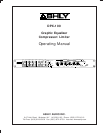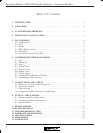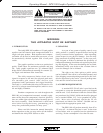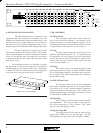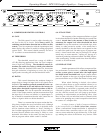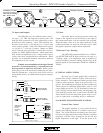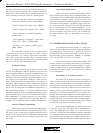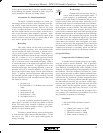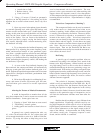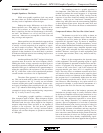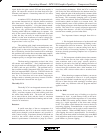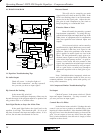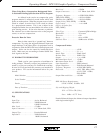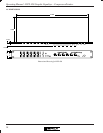
9
Operating Manual - DPX-100 Graphic Equalizer - Compressor/Limiter
if this type of transient doesn’t destroy a speaker outright,
it may damage the speaker surround in such a way as to
cause mechanical abrasion and future failure.
Alternatives For Sound Installations
To install a compressor/limiter in a sound sys-
tem using a passive crossover, insert it between your mix-
ing console output and the power amplifier input. For
systems using electronic crossovers, there are two ways
to use a compressor/limiter. It may be inserted between
the mixer output and the crossover input, in which case it
will act on the entire audio frequency spectrum. Alter-
nately, if the limiter is inserted between an output of the
electric crossover and the input of a power amp, it will
only affect a specific band of frequencies.
Recording
The Ashly limiter can be used to prevent tape
saturation in analog recording. Also, with modern trends
toward inexpensive digital recording, it remains neces-
sary to protect against input overload. With digital re-
cording, the information stored on tape, hard disk, optical
disk, etc., is either a 1 or 0, so actual signal level on the
tape is not the concern it is with analog recordings, in
fact it is not even a user controllable parameter. What is
of concern however, is the signal level applied to the A-D
(analog to digital) converters. If clipping occurs at the
converter input stage, the resulting distortion is most un-
pleasant, and will be recorded digitally as if they were
part of the original audio signal, forever mixed with the
audio. To prevent converter distortion while preserving
the extended dynamic range of digital recording, look up
the max input level of your recorder/converter and set up
the limiter as follows:
1. Set Gain to 0.
2. Set Threshold to 2-3 dB below max converter
input.
3. Set Ratio to 10.
4. Set Attack to 2 mS.
5. Set Release to .2 Sec.
6. Set Output level to 0.
If you are exceeding threshold frequently, your
input signal is probably too high and should be turned
down. Of course, every situation is different, so experi-
mentation before final recording is always a good idea,
but this is a good starting point.
To obtain a gentler limiting action at the expense
of some dynamic range, decrease the threshold to -15 and
the ratio to 3-5. This is also a good starting point for
analog recording.
Broadcasting
Compression has long been used as a
tool to make an audio signal appear louder. A
good example is in broadcasting, where com-
peting stations with identical transmitters and power at-
tempt to sound louder than each other. Since they are all
restricted with respect to maximum audio level (modula-
tion), their best tactic is to squeeze the dynamic range of
their programs to just a few dB. The audio output level
of the station virtually never changes, and the listener
perceives this continuous high-level sound as being louder
than the same material in an uncompressed form. Although
both compressed and uncompressed programs reach the
same peak levels, the compressed signal stays near peak
level more of the time, and thus sounds louder. This tech-
nique makes the broadcast more intelligible over ambi-
ent noise, and increases the geographical area over which
the broadcast is audible to the listener. Additionally, this
compression technique is extremely useful for FM and
infrared transmission systems for the hearing impaired.
8.3 Special Effects
Compression For Feedback Control
A common ritual in sound system set-up is equal-
izing the room to remove feedback. This is generally
accomplished by turning up system gain to purposely in-
duce feedback, searching for the center frequency of the
feedback, and then equalizing at that frequency to remove
the feedback. Once this frequency has been cut, system
gain is again increased to induce another feedback point,
and the whole procedure is repeated until the engineer is
satisfied that the significant problem frequencies have
been corrected. The major problem with this approach is
that the feedback can easily get out control, and the engi-
neer ends up dashing back and forth between the mixer
volume controls and the equalizer controls, while every-
one in the room plugs their ears and prays it will end
soon. The Ashly DPX-100 can turn this procedure into a
fast, painless job, eliminating loud feedback levels and
the possibility of speaker or ear damage.
Procedure:
1. Set up the DPX-100 limiter controls
as follows:
a. Output level control to -20dB.
b. Input Gain control to 0dB.
c. Threshold control to -30dB.
d. Ratio control to infinity (∞)



